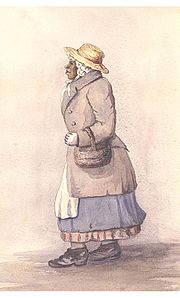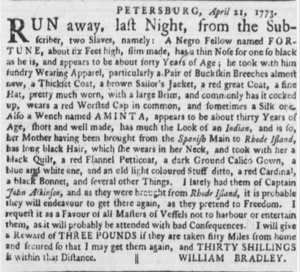Rose Fortune facts for kids
Quick facts for kids
Rose Fortune
|
|
|---|---|
 |
|
| Born | March 13, 1774 |
| Died | February 20, 1864 (aged 89) |
| Nationality | Canadian |
Rose Fortune (March 13, 1774 – February 20, 1864) was a brave and determined woman. She was born in Philadelphia to parents who sought freedom from slavery. During the American Revolutionary War, her family became Black Loyalists. This meant they supported the British Army to gain their freedom.
When Rose was about 10 years old, she sailed from New York City to Nova Scotia in 1783. She was one of about 3,000 Black Loyalists who made this journey. Later in life, around age 50, Rose started her own business. She transported luggage from the Annapolis ferry docks to hotels and homes. She began with a wheelbarrow and later used horse-drawn carriages. Rose Fortune is also known as the first female "police officer" in North America. She helped keep the streets safe by setting and enforcing curfews at night. People remember Rose for her smart business ideas, strength, and courage.
Contents
Rose Fortune's Early Life
Rose Fortune was born in Philadelphia, Pennsylvania, around March 13, 1774. Her parents, Fortune and Aminta, were of African, Madagascarian, and South American backgrounds.
A year before Rose was born, her parents were mentioned in a newspaper ad. This ad was about people who had left their owners. It was published in the Virginia Gazette on April 29, 1773. Rose's parents, Fortune and Aminta, had left on April 20. Fortune was about 40 years old and tall. Aminta was around 30 and looked like she had Native American heritage.
During the American Revolutionary War, the British offered freedom to enslaved people and free Black individuals. This was if they promised to be loyal to the British. Rose's family was among the 3,000 Black Loyalists who supported the British. After the war, they moved from New York to Nova Scotia, which was a British territory. In 1783, when Rose was about 10, they settled in Annapolis Royal.
Rose Fortune's Career and Business
Rose Fortune started her own business at a time when it was very hard for Black Canadians, especially women, to do so. Around 1825, she began moving travelers' luggage. She worked between the ferry docks and nearby homes and hotels in Annapolis Royal. She also met ferries arriving from Boston. Travelers trusted her to help them find places to stay and make their next travel connections.
By 1841, her business was known as Lewis Transfer. Around this time, she started using horse-drawn wagons to carry luggage. She would even wake up guests at inns so they wouldn't miss their ferries. One of her regular customers was Thomas Chandler Haliburton, a judge. She would wake him so he could travel to court on time.
I was aided in my hasty efforts to quit the abominable inn by a curious old Negro woman, rather stunted in growth… and dressed in a man’s coat and felt hat; she had a small stick in her hand which she applied lustily to the backs of all who did not jump instantly out of the way. Poor old dame! She was evidently a privileged character.
—Lieutenant-Colonel Sleigh of the 77th Regiment, 1852
Rose was well-known by the town's leaders. Her strong reputation meant she had little competition. Her honesty, trustworthiness, and constant presence at the waterfront led to a special role. She was trusted to protect property and keep order on the docks and in the warehouses of Annapolis Royal. She became like the town's waterfront police officer. For example, she created and enforced curfews to keep young boys from causing trouble. For a time, she was the only person in charge of law and order in Annapolis. She is believed to be the first female police officer in North America. Rose continued to work into her 70s.
Family Life and Passing
Rose Fortune was married more than once. She had at least three children, including two daughters. One daughter, Jane Fortune, married Isaac Godfrey. Her son, John, married Isaac's sister, Hester Godfrey, in 1838. Another daughter, Margaret Fortune, married John Francis by 1842.
Rose also helped other Black individuals escape slavery. She guided them to safe locations using the Underground Railroad.
In her later years, Rose had severe rheumatism, a condition causing joint pain. She passed away in Nova Scotia on February 20, 1864, at about 90 years old. Her funeral was held at St. Luke's Church of England in Annapolis Royal. She was buried at the Royal Garrison cemetery at Fort Anne. In 2017, a special marker was placed there to honor her. The marker is a stylized wheelbarrow made of iron and stone. It reminds people of her work and the business she started.
Rose Fortune's Legacy
When Black Loyalists like Rose Fortune came to Nova Scotia, they faced challenges. They experienced unfair treatment and fewer opportunities. Rose, however, became a respected and important member of her community. She created her own opportunities and is now known for her strength and pride among the African-Canadian community.
- The Rose Fortune Gate in Bedford, Nova Scotia is named after her.
- In 1999, a plaque honoring her was placed near her former home in Annapolis Royal.
- In May 2015, a new ferry was named the MV Fundy Rose in her honor. This ferry travels between Digby, Nova Scotia and Saint John, New Brunswick.
On January 12, 2018, Rose Fortune was named a National Historic Person. A special plaque was installed on July 20, 2019, at the Annapolis Royal waterfront where she worked. This plaque is on a large granite rock donated by one of her descendants.
A scholarship program, the Peter Butler III–Rose Fortune Scholarship Program, was created. It honors early Black police officers in Canada.
In Popular Culture
- Fortune is a play inspired by Rose Fortune's life. It has been performed in the United States and the Maritimes. The playwright, George Cameron Grant, was inspired by a graveyard tour in 2013.
- The film Rhythm Stick to Freedom tells the story of her life.




